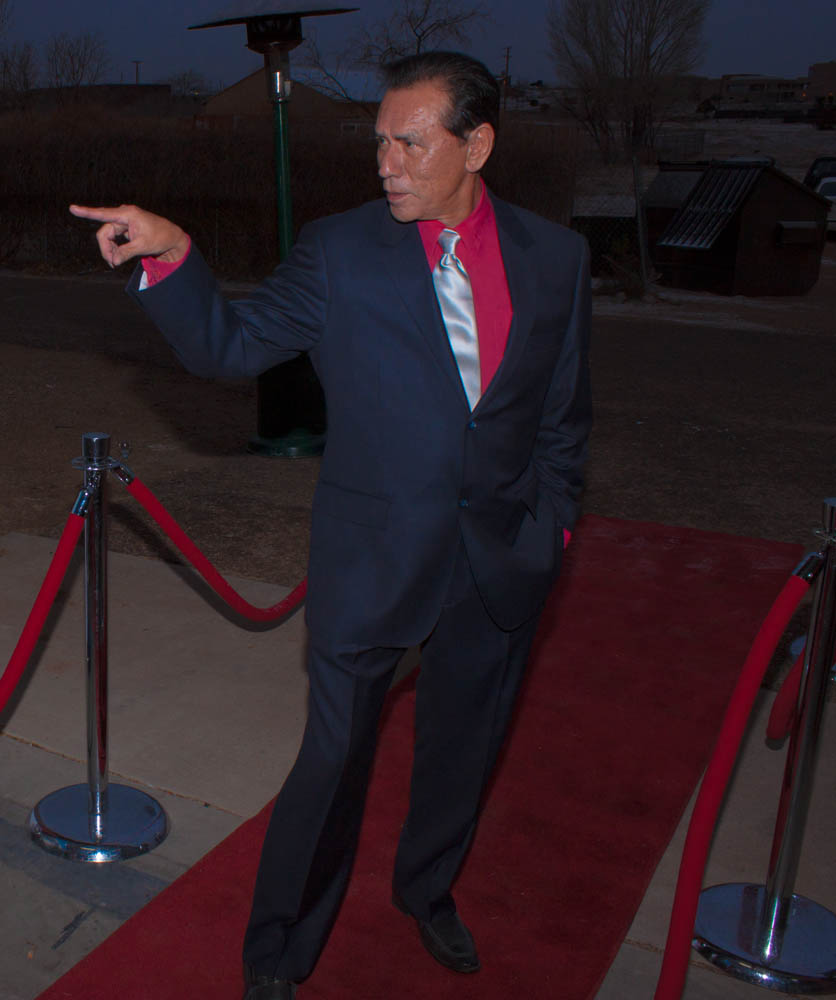The crews of Shoot the Stars have sprung into action. With star actors Richmond Arquette (Se7en and Fight Club) and Jordana Spiro (The Mob Doctor and Trespass) arriving on the SFUAD campus this weekend, the production crews of Mister Stapleton and Dead Celebrity have been working around the clock casting, scheduling, camera testing and the works.
2013 Launch of Shoot the Stars
posted by Charlotte Martinez
Tuesday, Sept 24, Film School Chairman Chris Eyre officially announced this year’s Shoot the Stars scripts, directors and producers. Two teams, two stars, two films! “These were extremely difficult selections,” Eyre writes in his email to film students, some of whom were disappointed not to see their names on the list of directors and producers. “We have so many talented students here at The Film School,” Eyre continues, “Hollywood, of course, is a place where ‘no’ is said a lot more than ‘yes.’” Last year, Eyre initiated the first of the Shoot the Stars projects, announcing that every year in November the Film School would hire two well-established “star” actors to work under two student-assembled film crews. The product would be two short films, produced entirely by the Santa Fe University of Art and Design Film School. For seven students, the announcement of scripts, directors and producers was taken with relief and great anticipation. “I’m dying to be a director,” says Joshua James, the official director for Baxter Smith’s screenplay, Mister Stapleton. When he was called for his interview, James explains, he didn’t know what to expect. “The email said you had to have a pitch ready…but when I got in there, it wasn’t so much a pitch as it was a conversation.” Similarly, Bonnie Burchfield, the Producer for Mister Stapleton, describes the interview with Assistant Chair Paula Amanda and Hank Rogerson, film production instructor, as a conversation between acquaintances.“It was very calm,” Burchfield says. “I didn’t feel like I was going into a tense situation. Hank has such a warm vibe about him anyway, he’s so soothing that it made me feel really confident.” Hank Rogerson, in charge of Shoot the Stars’ production team, explains that in selecting candidates for director and producer “faculty goes by class experience,… applications, GPA, and year. And then,” Rogerson adds, “it comes down to how they present themselves in the interview, through preparation, presentation and vision.” As upper classmen, both James and Burchfield share the benefit of having worked with the Film School staff. In anticipation of Shoot the Stars 2013, they’ve directed and produced their own students films. “What made the final selections stand out,” Rogerson says, “was how much they presented a whole package—from vision for the projects to track record in the department.” For those unfamiliar with the tasks of a film producer, Burchfield considers it the job suited for “real problem solvers.” “They’re there to do the business end,” she says. “The end that the director doesn’t want to think about.” In charge of budget for pre-production, production and post production, Burchfield says, “they stay with it through to the end, into marketing, into the film circuit.” The problem solving, Burchfield describes, comes in when the director’s vision does not match the boundaries of the budget. “They have to provide other options,” Burchfield says, “that stay within the creative vision of the director.” Speaking of directors, Joshua James, a senior of the Film School, says he had been thinking of signing up for Shoot the Stars since January. In anticipation, James directed and produced a student film in the Spring called Nightmares and Daydreams in hopes the addition to his resume would give him a leg up. With plenty of film directing under his belt, James says his theater background, five years acting and directing plays in high school, also came up during his interview. “Mister Stapleton is written a lot like a play,” James says. “Baxter described it as kind of a gloried sketch that can be performed live if it weren’t for particular elements. When Chris [Eyre] told me that I got the position, he told me that my theater experience was a big reason for it. He thought I’d be comfortable with the actors and I’d have a good understanding of how to communicate with them.” Terry Borst, screenwriting instructor for the Film School and...
Oscar Night at the Screen...
posted by Charlotte Martinez
By Charlotte Martinez/ Photos by Christopher Stahelin It’s all about timing and planning for the unexpected. That’s the movie business for you. The sky is clear at 3:30 p.m., Feb. 24 on the Santa Fe University of Art and Design campus. The Screen, SFUAD’s independent movie theater and my work place, has a sidewalk leading to the entrance and though the concrete is cracked and dusty, I feel like I’m passing Hollywood’s red carpet. There’s a lot of excitement the day of SFUAD’s Oscar Night, but like I said, the movie business isn’t predictable. Here at the Screen, Oscar Night means a live stream of the 2013 Academy Awards for students and faculty of the Film Department. In addition, this event premieres the Film School’s first Shoot the Stars production, two student-made films featuring big name actors Wes Studi, from Avatar, and Canadian actor Luke Kirby. My red carpet disappears, however, when I’m told we’re running 20 minutes behind. Peter Grendle, manager of the Screen and professor at the Film School, strides in with his usual short-breathe grin (I’m convinced he runs everywhere). I tell him our last movie will let out 20 minutes late. He says he knows and we make a plan. It’s 3:45 p.m. I smile at the gathering audience and promise that they’ll be let into the theater soon. There’s some confusion as to when the student films will begin. “We’re playing it by ear,” I say. This turns out partially true. For the first 30 minutes my ear stays glued to the theater’s closed doors, behind which Peter struggles to stream cable to both the Screen and the monitor down the hall in Studio C, where the Oscar party begins. This party is legit! Red carpet, decorations, paparazzi, finger...
The International Buzz...
posted by Charlotte Martinez
Story by Charlotte Martinez/ Photos by Michelle Rutt “There are three categories,” Emily Powell, advisor for the Santa Fe University of Art and Design, begins when describing Laureate’s Network programs. Powell’s desk in Mouton, as her advisees know, is tidy so little impedes her elbow space as she counts. “The first we call International like a student coming from China, for example. Then there’s the network students who come from Laureate Universities.” Her third finger extends to complete the categories, “and there’s study abroad, where our students go somewhere else.” Now in its third year of international immersion, SFUAD’s new owner, Laureate, provides an exchange of students on a world scale, inviting cultural as well as academic advancement. Currently, most of SFUAD’s network population comes from Mexico. “Some from Brazil,” Powell says, “only four from Turkey and one from Italy.” “One from Germany, China, Russia, Syria…all over.” Pablo Torrez, the International student coordinator, continues. His tasks of setting up visas and transferring credits connects him most to La Universidad del Valle in Mexico, but both Torrez and Powell believe this is due to Santa Fe’s proximity. Torrez hopes more bridges will extend to Santa Fe in the future, that way “everyone can learn from everyone.” He calculates that SFUAD’s International population, currently 11%, will continue growing as the school does. Of course, school exchange is also influenced by options. Juliana Ruette, a second semester student from Brazil says that there were very few choices offered in her previous school, “which was in a city close to Sao Paulo.” She wanted to leave Brazil, so she googled Santa Fe and thought, “what the fuck! It’s so brown!” Agreeing that Santa Fe would be better than Brazil, she planned on attended SFUAD for one semester then escaping to California. Those plans changed. With marketing...





 Jackalope Magazine is the student magazine of Santa Fe University of Art and Design. Building on the interdisciplinary nature of our education, we aim to showcase the talent of our university and character of our city.
Jackalope Magazine is the student magazine of Santa Fe University of Art and Design. Building on the interdisciplinary nature of our education, we aim to showcase the talent of our university and character of our city.
Recent Comments